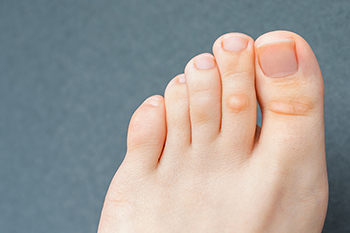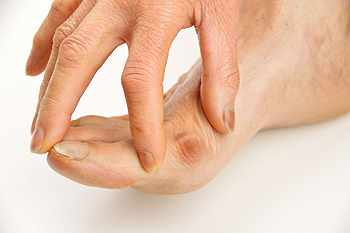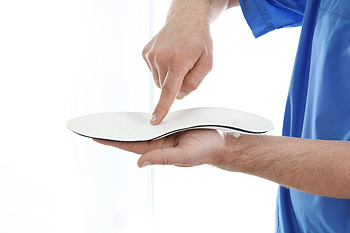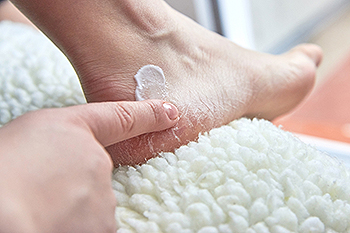1648 US Highway 130
North Brunswick, NJ 08902

A foot corn is a thick, hardened area of skin on the foot that usually comes as a result of friction on the feet from shoes. They are the body’s way of protecting the skin underneath. There are a number of methods used to treat corns—from home products for softening the corn like castor oil or pumice stones to surgery. Ways to prevent corns include keeping feet clean, dry, and moisturized. Other methods include wearing comfortable, well-fitting shoes that do not pinch the foot, using corn pads to cover the corn while it is healing, and trimming toenails regularly so pressure that leads to corns does not develop. Usually corns are not serious, however there are times when they can become painful and in need of professional examination by a podiatrist. It is especially important for those with diabetes to consult with a podiatrist at their earliest convenience as they can suffer from numbness and neuropathy. This makes it hard for them to detect a developing infection of the foot.
If you have any concerns regarding your feet and ankles, contact Dr. Robert Fink of Brunswick Foot & Ankle Group. Our doctor will treat your foot and ankle needs.
Corns: What Are They? and How Do You Get Rid of Them?
Corns can be described as areas of the skin that have thickened to the point of becoming painful or irritating. They are often layers and layers of the skin that have become dry and rough, and are normally smaller than calluses.
Ways to Prevent Corns
There are many ways to get rid of painful corns such as wearing:
Treating Corns
Treatment of corns involves removing the dead skin that has built up in the specific area of the foot. Consult with Our doctor to determine the best treatment option for your case of corns.
If you have any questions please feel free to contact our office located in North Brunswick, NJ . We offer the newest diagnostic and treatment technologies for all your foot and ankle needs.
 A bunion, or hallux valgus, is a bony bump on the side and base of the big toe. These develop from pressure put on the big toe joint and causes the toe to move out of place and lean inward toward the second toe. Because the big toe carries a lot of weight in standing, walking, and all activities we do, a bunion can cause pain, stiffness, redness, and swelling. Calluses can also form where the big and second toe rub against each other or on the ball of the foot. Untreated, bunions can become worse, and it may be difficult to wear regular shoes or walk comfortably. They can occur on one or both feet. It is rare but possible that children are born with bunions (known as congenital hallux valgus) or develop them later in childhood (juvenile or adolescent hallux valgus). Most often bunions occur in adulthood. They are more common in women, perhaps because of their unique foot anatomy, footwear choices or genetics. Wearing shoes that are too tight, have high heels, or insufficient room in the toe box, and those with some medical conditions (like rheumatoid arthritis) are more prone to developing bunions as well. If you have a bunion that has become uncomfortable, consult with a podiatrist who can provide remedies to restore you to better functioning.
A bunion, or hallux valgus, is a bony bump on the side and base of the big toe. These develop from pressure put on the big toe joint and causes the toe to move out of place and lean inward toward the second toe. Because the big toe carries a lot of weight in standing, walking, and all activities we do, a bunion can cause pain, stiffness, redness, and swelling. Calluses can also form where the big and second toe rub against each other or on the ball of the foot. Untreated, bunions can become worse, and it may be difficult to wear regular shoes or walk comfortably. They can occur on one or both feet. It is rare but possible that children are born with bunions (known as congenital hallux valgus) or develop them later in childhood (juvenile or adolescent hallux valgus). Most often bunions occur in adulthood. They are more common in women, perhaps because of their unique foot anatomy, footwear choices or genetics. Wearing shoes that are too tight, have high heels, or insufficient room in the toe box, and those with some medical conditions (like rheumatoid arthritis) are more prone to developing bunions as well. If you have a bunion that has become uncomfortable, consult with a podiatrist who can provide remedies to restore you to better functioning.
If you are suffering from bunion pain, contact Dr. Robert Fink of Brunswick Foot & Ankle Group. Our doctor can provide the care you need to keep you pain-free and on your feet.
What Is a Bunion?
Bunions are painful bony bumps that usually develop on the inside of the foot at the joint of the big toe. As the deformity increases over time, it may become painful to walk and wear shoes. Women are more likely to exacerbate existing bunions since they often wear tight, narrow shoes that shift their toes together. Bunion pain can be relieved by wearing wider shoes with enough room for the toes.
Causes
Symptoms
In order to diagnose your bunion, your podiatrist may ask about your medical history, symptoms, and general health. Your doctor might also order an x-ray to take a closer look at your feet. Nonsurgical treatment options include orthotics, padding, icing, changes in footwear, and medication. If nonsurgical treatments don’t alleviate your bunion pain, surgery may be necessary.
If you have any questions, please feel free to contact our office located in North Brunswick, NJ . We offer the newest diagnostic and treatment technologies for all your foot care needs.

When visiting a podiatrist, you will be able to consult with medical professionals who can help you create treatment plans for foot afflictions you might have. Depending on your affliction, a podiatrist may recommend the use of orthotics for your feet. Orthotics are specially designed full shoe inserts, heel inserts, and other devices that are meant to provide support or correction to your feet. Unlike inserts that you may be able to purchase at the pharmacy, orthotics are personalized and built to fit your specific foot. Orthotics may be used to rectify deformities in the structure of the foot, support the ankle, or improve foot functioning. These devices have been used to help patients suffering from conditions including arthritis, heel spurs, high arches, plantar fasciitis, bunions, and back pain. Orthotics can be built with rigid materials and significantly flexible substances. While many patients have benefitted from the use of orthotics, success is largely dependent on several factors such as the kind of shoe to which the orthotics are applied as well as the amount of time that the patient actually wears the devices. Each patient is understandably different, and so you might consider consulting with a podiatrist to determine whether or not orthotics could help you address your foot conditions.
If you are having discomfort in your feet and would like to try orthotics, contact Dr. Robert Fink from Brunswick Foot & Ankle Group. Our doctor can provide the care you need to keep you pain-free and on your feet.
What Are Orthotics?
Orthotics are inserts you can place into your shoes to help with a variety of foot problems such as flat feet or foot pain. Orthotics provide relief and comfort for minor foot and heel pain but can’t correct serious biomechanical problems in your feet.
Over-the-Counter Inserts
Orthotics come in a wide variety of over-the-counter inserts that are used to treat foot pain, heel pain, and minor problems. For example, arch supports can be inserted into your shoes to help correct overarched or flat feet, while gel insoles are often used because they provide comfort and relief from foot and heel pain by alleviating pressure.
Prescription Orthotics
If over-the-counter inserts don’t work for you or if you have a more severe foot concern, it is possible to have your podiatrist prescribe custom orthotics. These high-quality inserts are designed to treat problems such as abnormal motion, plantar fasciitis, and severe forms of heel pain. They can even be used to help patients suffering from diabetes by treating foot ulcers and painful calluses and are usually molded to your feet individually, which allows them to provide full support and comfort.
If you are experiencing minor to severe foot or heel pain, it’s recommended to speak with your podiatrist about the possibilities of using orthotics. A podiatrist can determine which type of orthotic is right for you and allow you to take the first steps towards being pain-free.
If you have any questions please contact our office located in North Brunswick, NJ . We offer the newest diagnostic and treatment technologies for all your foot and ankle needs.

The foot condition known as cracked heels can be unsightly and uncomfortable. In severe cases, it can be difficult to walk and an infection may develop. There are several reasons why this ailment occurs. These can include dehydration from not drinking enough water or from using harsh soaps on the feet. Additionally, there may be existing medical conditions that can cause cracked heels like eczema and psoriasis. Some people may experience this condition from living in extremely cold environments or from using excessively hot water while taking a shower. Mild relief may be found when the feet are washed and dried thoroughly, followed by applying a good moisturizer. It may also help to refrain from wearing shoes that have an open back as well as drink plenty of fresh water daily. Cracked heels can require professional medical attention and it is suggested that you use the services of a podiatrist who can effectively treat this condition.
Cracked heels are unsightly and can cause further damage to your shoes and feet. If you have any concerns, contact Dr. Robert Fink from Brunswick Foot & Ankle Group. Our doctor can provide the care you need to keep you pain-free and on your feet.
Cracked Heels
Cracked heels appear unappealing and can make it harder for you walk around in sandals. Aside from looking unpleasant, cracked heels can also tear stockings, socks, and wear out your shoes. There are several methods to help restore a cracked heel and prevent further damage.
How Do You Get Them?
Dry skin is the number one culprit in creating cracked heels. Many athletes, walkers, joggers, and even swimmers suffer from cracked heels. Age and skin oil production play a role to getting cracked heels as well.
Promote Healing
Over the counter medicines can help, especially for those that need instant relief or who suffer from chronic dry feet.
Wear Socks – Wearing socks with medicated creams helps lock in moisture.
Moisturizers – Applying both day and night will help alleviate dryness which causes cracking.
Pumice Stones – These exfoliate and remove dead skin, which allows for smoother moisturizer application and better absorption into the skin.
Change in Diet
Eating healthy with a well-balanced diet will give the skin a fresh and radiant look. Your body responds to the kinds of food you ingest. Omega-3 fatty acids and zinc supplements can also revitalize skin tissue.
Most importantly, seek professional help if unsure how to proceed in treating cracked heels. A podiatrist will help you with any questions or information needed.
If you have any questions, please feel free to contact our office located in North Brunswick, NJ . We offer the newest diagnostic and treatment technologies for all your foot care needs.